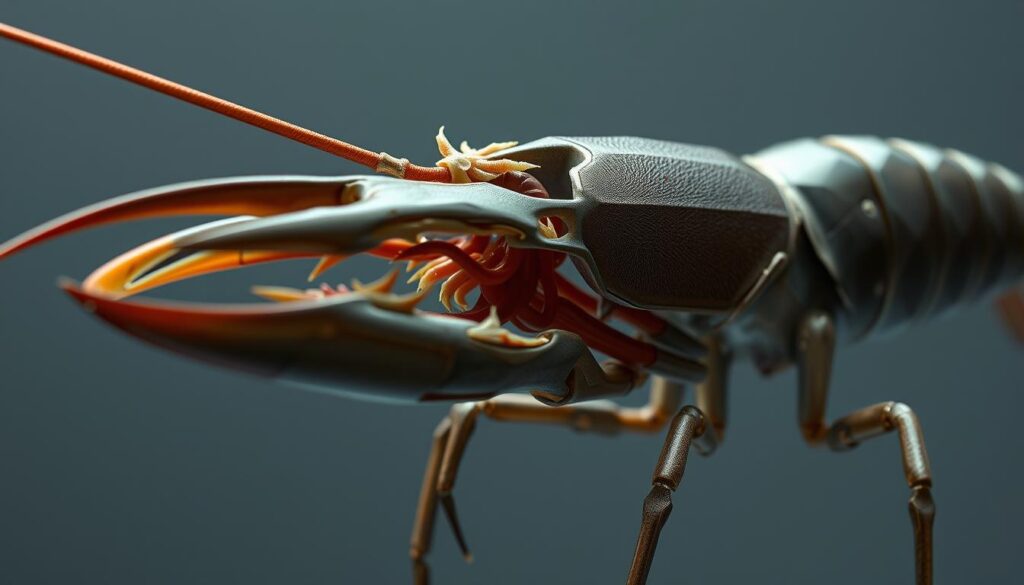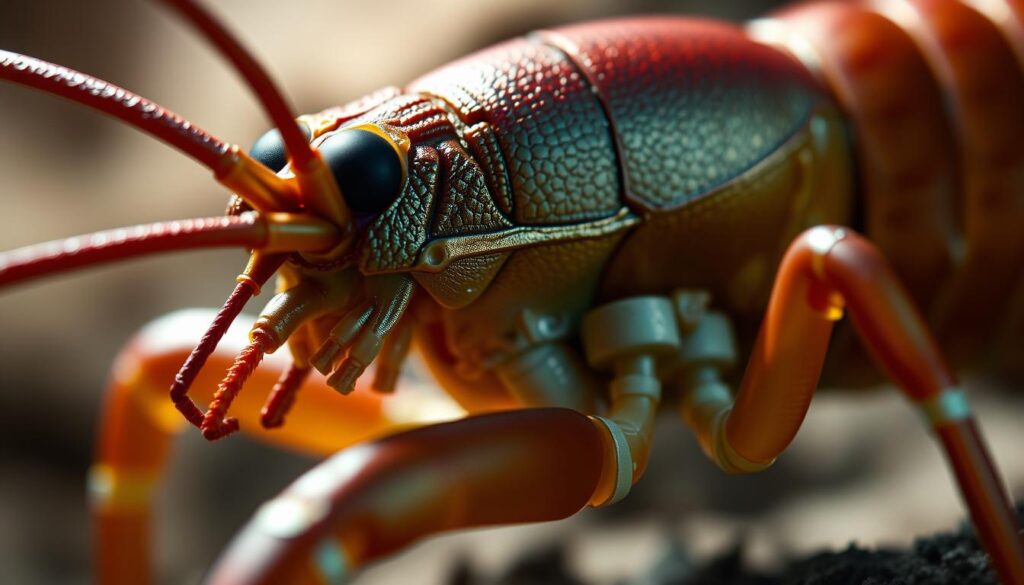Did you know that some mantis shrimp can deliver a punch so powerful it can shatter aquarium glass? These tiny marine creatures, often no larger than a human thumb, are packed with extraordinary features that have fascinated researchers and aquarium enthusiasts alike.
With over 450 species, mantis shrimp (or stomatopods) are a testament to nature’s ingenuity. Each species boasts unique colors and adaptations, making them one of the most diverse groups in the ocean. My journey into understanding these remarkable crustaceans began with their exoskeletons—sleek, durable, and yet incredibly lightweight.
Recent breakthroughs in high-speed imaging have unveiled the lightning-fast strikes of mantis shrimp, which can reach speeds of up to 50 miles per hour. This technology has also revealed the physics behind their deadly claws, which can create cavitation bubbles powerful enough to stun prey.
In this article, we’ll explore the intricate details of mantis shrimp anatomy, from their formidable claws to their advanced visual systems. We’ll delve into how their exoskeletal design supports their high-impact lifestyle and examine the adaptive behaviors that make them such successful predators.
Key Takeaways
- Mantis shrimp are capable of delivering punches that can shatter glass.
- There are over 450 species, each with unique adaptations and colors.
- Their claws can strike at speeds of up to 50 miles per hour.
- High-speed imaging has revealed the physics behind their powerful strikes.
- Mantis shrimp possess advanced visual systems with 16 types of photoreceptors.
Understanding Mantis Shrimp Anatomy
The mantis shrimp, a small but formidable crustacean, has evolved over millions of years to develop some of the most advanced anatomical features in the ocean. Their unique appendages and streamlined bodies are a testament to nature’s engineering prowess. This section delves into how these features came to be and how modern technology has deepened our understanding of them.
Evolution of Their Distinctive Features
Over 250 million years, mantis shrimp have developed remarkable appendages known as raptorial claws. These claws are not just for show; they are precision tools designed for hunting and defense. Early studies revealed that these appendages evolved to deliver lightning-fast strikes, capable of stunning prey in milliseconds. The evolutionary journey of these features is a fascinating story of adaptation and specialization.
High-speed imaging has been instrumental in capturing the rapid movements of these appendages. By filming in water, scientists have observed how mantis shrimp can create cavitation bubbles with their strikes. These bubbles are so powerful that they can stun prey or even break through glass. The interplay of light and time in these images has exposed biological phenomena that were previously invisible to us.
Breakthrough Imaging Techniques
Recent advancements in imaging technology have revolutionized our understanding of mantis shrimp anatomy. High-speed cameras can now capture their movements in unprecedented detail, showing how their appendages generate immense force. These images reveal the intricate mechanics behind their strikes and how they achieve such speed and power in water.
By analyzing these images, researchers can measure the force of their strikes and observe cavitation bubbles in action. This has provided new insights into how mantis shrimp interact with their environment and how their systems have adapted over time. The clarity of these images has also allowed for comparisons with other crustaceans, highlighting the unique features of mantis shrimp.
In summary, the combination of evolutionary adaptation and advanced imaging techniques has given us a clearer picture of mantis shrimp anatomy. Their distinctive appendages and the systems that support them are a marvel of nature, and continued research promises to uncover even more secrets about these incredible creatures.
The Mechanics Behind Their Deadly Claws

The extraordinary claws of mantis shrimp are a marvel of evolutionary engineering. These appendages, known as raptorial appendages, function like biological hammers, delivering strikes with breathtaking speed and force. Scientists have uncovered the intricate mechanics behind these deadly claws through high-speed imaging and force sensors.
Raptorial Appendage and Strike Dynamics
The raptorial appendage is engineered for extreme speed and power. A 4-bar linkage system and spring-loaded latches work together to store and release energy, enabling the shrimp to strike with forces that can exceed 2500 times their body weight. This combination of muscle power and elastic energy storage is a key factor in their remarkable striking ability.
Cavitation and Impact Force
When a mantis shrimp strikes, it creates a cavitation bubble—a vapor bubble that forms and collapses with incredible force. This collapse produces additional impact force, accompanied by heat, light, and sound. High-speed imaging has revealed that each strike generates multiple force peaks, first from the direct impact and then from the cavitation bubble’s collapse. This phenomenon is a groundbreaking discovery in biomechanics.
These findings highlight the remarkable efficiency of the mantis shrimp’s strike mechanism, which combines direct impact with the explosive force of cavitation. Such biological feats continue to inspire wonder and curiosity, offering insights that could influence human engineering.
Exploring the Exoskeleton and Body Structure

The mantis shrimp’s exoskeleton is a remarkable blend of strength and flexibility, playing a crucial role in their survival. This section dives into the intricate design of their shell, segmented body, and the functional roles each part plays.
Carapace, Abdomen, and Telson Characteristics
The carapace, or shell, acts as a protective armor for the upper body. It’s designed to withstand the rigors of the mantis shrimp’s high-impact lifestyle, providing a durable yet lightweight shield. This resilience is key to their ability to thrive in diverse marine environments.
The abdomen is divided into clear segments, each contributing to the shrimp’s mobility. These segments work together to enhance flexibility and movement, allowing precise control during hunting and navigation. The structure of each segment is a testament to evolutionary optimization.
The telson, located at the tail end, serves multiple functions. It aids in defense by providing a protective barrier and helps seal burrows, safeguarding the shrimp’s shelter. This dual-purpose design underscores the practicality of their anatomy.
Species identification can often be aided by the unique patterns and colors on their shells. These variations not only help in distinguishing species but also suggest adaptational responses to different environments. Such diversity highlights the intricate interplay between form and function in their exoskeletal design.
In observing these creatures, I’ve noted how their exoskeletons balance strength with flexibility. This balance is a marvel, offering insights that could inspire human engineering, particularly in materials science. The mantis shrimp’s body is a living example of mechanical optimization, where every part is finely tuned for both protection and functionality.
Sensory Systems and Extraordinary Visual Capabilities
The mantis shrimp’s visual system is one of the most complex in the animal kingdom, making it a fascinating subject of study. Each eye operates independently, providing unparalleled depth perception and the ability to detect polarized light, which is crucial for both hunting and communication.
Complexity of the Mantis Shrimp Eye
The eye of a mantis shrimp is equipped with up to 16 physiologically distinct photoreceptor classes, allowing it to perceive ultraviolet light and detect polarized light with exceptional accuracy. This ability gives them a significant ecological edge, enabling them to navigate and hunt effectively in diverse marine environments.
One of the most remarkable features of the mantis shrimp’s visual system is its ability to move each eye independently. This allows the shrimp to have a wide field of vision and ensures that even if one eye is damaged, the other can still function effectively. This adaptability is crucial for their survival in the wild.
Studies have shown that mantis shrimp can detect wavelengths ranging from deep ultraviolet to red, and they possess 12 distinct types of photoreceptors. This is far more than any other known animal, including humans, who have only three types of photoreceptors. Their ability to detect circularly polarized light is particularly notable and is used for communication, especially during mating.
The peacock mantis shrimp, known for its vibrant colors, uses its advanced visual system to communicate territory and mating signals. The intricate patterns and colors on their shells are not just for show; they play a vital role in their social interactions. This unique visual communication system is enhanced by their ability to perceive light in various forms, making them one of the most visually sophisticated creatures in the ocean.
Research has also revealed that mantis shrimp can make quick and reliable color determinations without extensive neural processing. This ability is essential for their survival in coral reef environments, where rapid decision-making can mean the difference between life and death. Their visual system is a testament to the incredible diversity and complexity of life in the ocean.
Behavioral Insights and Habitat Adaptations
Mantis shrimp are fascinating creatures, not just because of their physical features, but also due to their complex behaviors. These small crustaceans have evolved unique ways to interact with their environment, making them some of the most intriguing animals in the ocean.
Burrowing Habits and Territoriality
Mantis shrimp are known for their elaborate burrowing habits. They often construct U-shaped burrows near coral reefs, which serve as both shelters and ambush points for hunting. These burrows are not just simple holes in the sand; they are complex structures that require significant effort and engineering skills.
- Mantis shrimp use their powerful claws to excavate sand and create intricate tunnel systems.
- These burrows are often equipped with multiple entrances and exits, providing escape routes and vantage points for hunting.
- Some species even decorate their burrows with shells and other materials, possibly for camouflage or communication.
Territoriality is another key aspect of mantis shrimp behavior. They are highly protective of their burrows and will fiercely defend them against intruders. This territorial behavior is crucial for their survival, as it ensures they have a safe place to rest and store food.
Shrimp Use of Claws Beyond Hunting
While their claws are primarily used for hunting, mantis shrimp also use them for other purposes. For example, they can use their claws to signal aggression or attract mates. This dual functionality highlights the versatility of their anatomy.
- Mantis shrimp use their claws to signal aggression or attract mates.
- They also use their claws to manipulate objects in their environment, such as moving rocks or arranging materials for their burrows.
- In some cases, mantis shrimp have even been observed using their claws to “wave” at each other, a behavior that is thought to be a form of communication.
These behaviors are not just random actions; they are highly coordinated and serve specific purposes. For example, the way they move their claws during a territorial dispute is different from how they move them when hunting. This level of coordination suggests a high degree of intelligence and adaptability.
Range of Environments and Anatomical Adaptations
Mantis shrimp can be found in a wide range of environments, from shallow, tropical waters to deeper, cooler areas. This diversity in their range is supported by their anatomical features, which allow them to adapt to different conditions.
- Mantis shrimp have evolved specialized appendages that enable them to move efficiently in both sandy and rocky environments.
- Their exoskeletons are designed to withstand the pressures of deep water, while also providing flexibility for movement in shallower areas.
- Some species even have adaptations that allow them to survive in brackish or freshwater environments, further expanding their range.
These adaptations are crucial for their survival and success in various habitats. By understanding how mantis shrimp have evolved to thrive in different environments, we can gain insights into the complex interactions between anatomy, behavior, and ecology.
Dynamic Movement Patterns and Biomechanical Implications
Mantis shrimp are known for their rapid and precise movements. Their ability to move quickly and change direction is essential for both hunting and escaping predators. These movement patterns are not just random; they are highly coordinated and have significant biomechanical implications.
- The speed and agility of mantis shrimp allow them to catch prey that other predators might miss.
- Their movement patterns also play a role in communication and territorial disputes, as they use their movements to signal aggression or courtship.
- Even slight changes in their movement patterns can have significant effects on their hunting success and overall survival.
These dynamic movement patterns are a testament to the evolutionary pressures that have shaped the behavior and anatomy of mantis shrimp. By studying these movements, we can gain a deeper understanding of the intricate relationships between behavior, anatomy, and environment.
In conclusion, the behavioral adaptations and habitat preferences of mantis shrimp are deeply intertwined with their anatomy and ecological role. Their burrowing habits, territorial behaviors, and dynamic movement patterns all contribute to their success as predators and their ability to thrive in a wide range of environments. By exploring these aspects of their biology, we can gain a greater appreciation for the complexity and diversity of life in the ocean.
Conclusion
In conclusion, the mantis shrimp stands as a remarkable example of evolutionary ingenuity, blending powerful appendages with advanced sensory systems. Their ability to generate force through both physical strikes and cavitation bubbles makes them formidable predators. The intricate design of their eyes, capable of detecting polarized light, highlights their unique visual capabilities, which are crucial for survival and communication.
Their adaptability extends beyond physiology; mantis shrimp have developed complex behaviors, from elaborate burrowing to territorial displays. These traits, combined with their ability to thrive in diverse marine environments, underscore their ecological success. Understanding these creatures offers valuable insights for both scientists and aquarium enthusiasts, revealing the intricate interplay between anatomy, behavior, and environment.
As we continue to explore the wonders of mantis shrimp, their remarkable abilities remind us of the awe-inspiring complexity of marine life. Their story is one of adaptation and resilience, inviting us to delve deeper into the fascinating world beneath the waves.
FAQ
What makes the appendages of mantis shrimp so powerful?
How fast can mantis shrimp strike their prey?
What is a cavitation bubble, and how do mantis shrimp use it?
How do mantis shrimp protect themselves with their exoskeleton?
Can mantis shrimp see in multiple colors?
Where do mantis shrimp typically live?
How do mantis shrimp use their tails?
Are mantis shrimp good for aquariums?
References
| Organization Name | URL |
|---|---|
| International Union for Conservation of Nature (IUCN) | https://www.iucnredlist.org |
| Great Barrier Reef Foundation | https://www.barrierreef.org/the-reef/animals/mantis-shrimp |
| Oceana | https://oceana.org/marine-life/peacock-mantis-shrimp/ |
| Discovery of Sound in the Sea (DOSITS) | https://dosits.org/galleries/audio-gallery/marine-invertebrates/mantis-shrimp/ |
| Monterey Bay Aquarium | https://www.montereybayaquarium.org/stories/meet-the-mantis-shrimp |







